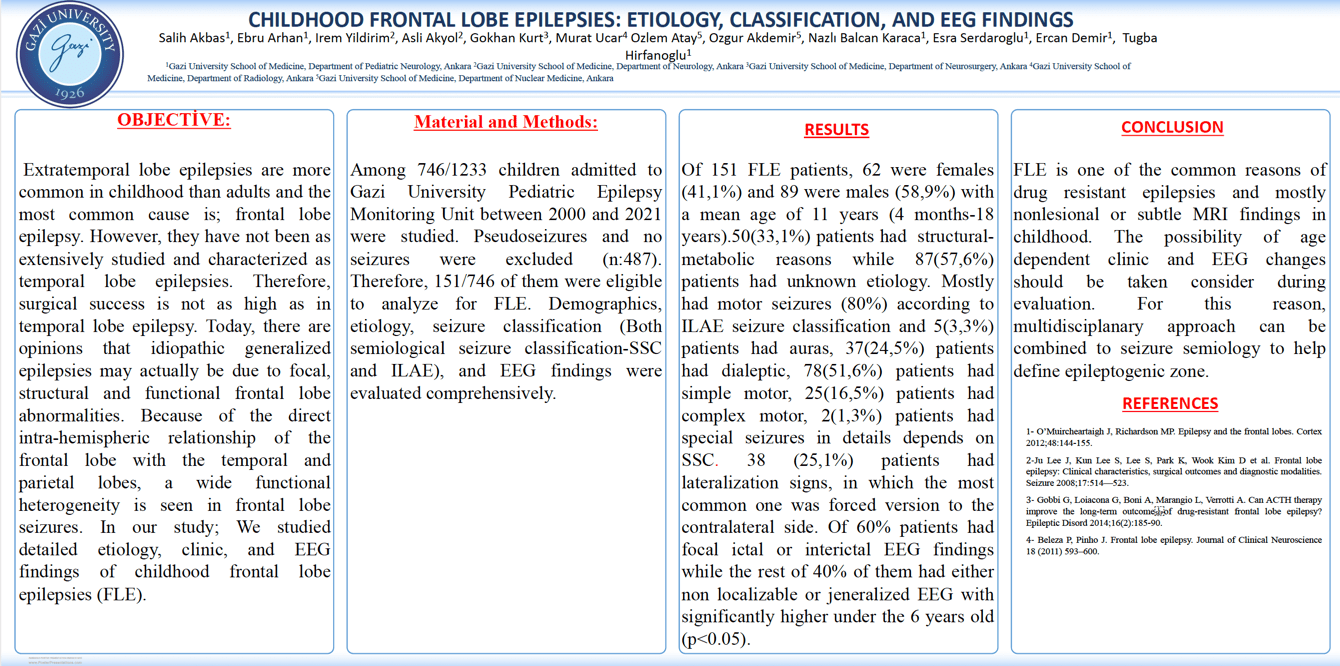Childhood Frontal Lobe Epilepsies: Etiology, Classification, and EEG Findings
Salih Akbaş, Ebru Arhan, Irem Yildirim, Aslı Akyol, Gokhan Kurt, Murat Ucar, Lütfiye Ozlem Atay, Ümit Ozgur Akdemir, Nazlı Balcan Karaca, Esra Serdaroğlu, Ercan Demir, Tugba Hırfanoglu
Objective: We studied detailed etiology, clinic, and EEG findings of childhood frontal lobe epilepsies (FLE).
Material and Methods: Among 746/1233 children admitted to Gazi University Pediatric Epilepsy Monitoring Unit between 2000 and 2021 were studied. Pseudoseizures and no seizures were excluded (n:487). Therefore, 151/746 of them were eligible to analyze for FLE. Demographics, etiology, seizure classification (Both semiological seizure classification-SSC and ILAE), and EEG findings were evaluated comprehensively.
Results: Of 151FLE patients, 62 were females (41,1%) and 89 were males (58,9%) with a mean age of 11 years (4 months-18 years). 50(33,1%) patients had structural-metabolic reasons while 87(57,6%) patients had unknown etiology. Mostly had motor seizures (80%) according to ILAE seizure classification and 5(3,3%) patients had auras, 37(24,5%) patients had dialeptic, 78(51,6%) patients had simple motor, 25(16,5%) patients had complex motor, 2(1,3%) patients had special seizures in details depends on SSC. 38 (25,1%) patients had lateralization signs, in which the most common one was forced version to the contralateral side. Of 60% patients had focal ictal or interictal EEG findings while the rest of 40% of them had either non localizable or jeneralized EEG with significantly higher under the 6 years old (p<0.05).
Conclusions: FLE is one of the common reasons of drug resistant epilepsies and mostly nonlesional or subtle MRI findings in childhood. The possibility of age dependent clinic and EEG changes should be taken consider during evaluation. For this reason, multidisciplanary approach can be combined to seizure semiology to help define epileptogenic zone.
Keywords: Epilepsy, FLE, etiology, seizure semiology, EEG
Salih Akbaş
Gazi University Medical Faculty
Turkey
Ebru Arhan
Gazi University Medical Faculty
Turkey
Irem Yildirim
Gazi University Medical Faculty
Turkey
Aslı Akyol
Gazi University Medical Faculty
Turkey
Gokhan Kurt
Gazi University Medical Faculty
Turkey
Murat Ucar
Gazi University Medical Faculty
Turkey
Objective: We studied detailed etiology, clinic, and EEG findings of childhood frontal lobe epilepsies (FLE).
Material and Methods: Among 746/1233 children admitted to Gazi University Pediatric Epilepsy Monitoring Unit between 2000 and 2021 were studied. Pseudoseizures and no seizures were excluded (n:487). Therefore, 151/746 of them were eligible to analyze for FLE. Demographics, etiology, seizure classification (Both semiological seizure classification-SSC and ILAE), and EEG findings were evaluated comprehensively.
Results: Of 151FLE patients, 62 were females (41,1%) and 89 were males (58,9%) with a mean age of 11 years (4 months-18 years). 50(33,1%) patients had structural-metabolic reasons while 87(57,6%) patients had unknown etiology. Mostly had motor seizures (80%) according to ILAE seizure classification and 5(3,3%) patients had auras, 37(24,5%) patients had dialeptic, 78(51,6%) patients had simple motor, 25(16,5%) patients had complex motor, 2(1,3%) patients had special seizures in details depends on SSC. 38 (25,1%) patients had lateralization signs, in which the most common one was forced version to the contralateral side. Of 60% patients had focal ictal or interictal EEG findings while the rest of 40% of them had either non localizable or jeneralized EEG with significantly higher under the 6 years old (p<0.05).
Conclusions: FLE is one of the common reasons of drug resistant epilepsies and mostly nonlesional or subtle MRI findings in childhood. The possibility of age dependent clinic and EEG changes should be taken consider during evaluation. For this reason, multidisciplanary approach can be combined to seizure semiology to help define epileptogenic zone.
Keywords: Epilepsy, FLE, etiology, seizure semiology, EEG
Salih Akbaş
Gazi University Medical Faculty
Turkey
Ebru Arhan
Gazi University Medical Faculty
Turkey
Irem Yildirim
Gazi University Medical Faculty
Turkey
Aslı Akyol
Gazi University Medical Faculty
Turkey
Gokhan Kurt
Gazi University Medical Faculty
Turkey
Murat Ucar
Gazi University Medical Faculty
Turkey

Salih Akbaş
Gazi University Medical Faculty Turkey
Gazi University Medical Faculty Turkey